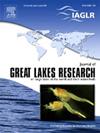Lake-bottom geology of the Chicago nearshore: A sand-distribution context for urban beach morphodynamics along a fragmented littoral zone
IF 2.4
3区 环境科学与生态学
Q3 ENVIRONMENTAL SCIENCES
引用次数: 0
Abstract
This paper reports on a high-resolution, regional sand assessment of the Chicago littoral zone, undertaken within ∼ 3 km from shore, to facilitate an improved process-based understanding of pocket-beach morphodynamics between the distinctive North and South sides of the Chicago Lake Michigan shoreline. While past studies have touched upon regional themes of sand limitation and littoral fragmentation by lakefill peninsulas and engineered shoreline infrastructure at these two areas, the integration of digital ‘chirper’ marine seismic reflection data (collected in 2022), geologic information from newly acquired sediment cores and lake-bottom grab samples (from 2023), and a 2020 LiDAR-based topobathymetric DEM provided the basis for geological lake-bottom unit characterization and delineation, a context for morphodynamics. Major findings are that: (1) The sandy lake bottom is distinct in bathymetric character from other compositions/textures, including bedrock, gravel-lag, and muddy sediments; (2) the Chicago North Side is sandier than the Chicago South Side; (3) sand thickness is greatest beneath urban pocket beaches and decreases sharply at the transition from engineered embayment to open lake environment; (4) sand thickness beyond semi-confinement is generally < 1 m, with the toe of the littoral sand wedge generally in > 5 m water depth; and (5) while the Chicago North Side littoral zone is continuously sandy alongshore, with few obstructions impacting unit continuity, that of the South Side is characterized by littoral fragmentation given exposure of bedrock highs. Differences in framework geology between Chicago North and South Sides are further enhanced by engineered shoreline structures and therewith associated littoral fragmentation.芝加哥近岸的湖底地质:沿破碎沿岸带城市海滩形态动力学的砂分布背景
本文报告了对芝加哥沿岸地区进行的高分辨率区域沙地评估,评估范围为距海岸 3 公里以内的区域,目的是促进对芝加哥密歇根湖海岸线南北两侧独特的袋滩形态动力学过程的理解。虽然过去的研究已经涉及到这两个地区的湖滨填湖半岛和工程海岸线基础设施造成的沙质限制和滨岸破碎的区域性主题,但数字 "啁啾 "海洋地震反射数据(2022 年收集)、新获得的沉积物岩心和湖底抓取样本(2023 年)中的地质信息以及 2020 年基于激光雷达的地形测量 DEM,为湖底地质单元的特征描述和划分提供了基础,也为形态动力学提供了背景。主要发现有(1) 沙质湖底在测深特征上有别于其他成分/质地,包括基岩、砾石礁和泥质沉积物;(2) 芝加哥北区的沙质比芝加哥南区的沙;(3) 城市袋形海滩下的沙厚度最大,从工程堤坝过渡到开放湖泊环境时沙厚度急剧下降;(4) 半固结区以外的沙层厚度一般为 5 米水深;以及 (5) 芝加哥北区沿岸地区沿岸为连续沙层,影响单元连续性的障碍物较少,而南区沿岸地区由于基岩高地的暴露而呈现出沿岸破碎的特点。工程海岸线结构进一步加剧了芝加哥北区和南区的框架地质差异,从而导致沿岸破碎。
本文章由计算机程序翻译,如有差异,请以英文原文为准。
求助全文
约1分钟内获得全文
求助全文
来源期刊

Journal of Great Lakes Research
生物-海洋与淡水生物学
CiteScore
5.10
自引率
13.60%
发文量
178
审稿时长
6 months
期刊介绍:
Published six times per year, the Journal of Great Lakes Research is multidisciplinary in its coverage, publishing manuscripts on a wide range of theoretical and applied topics in the natural science fields of biology, chemistry, physics, geology, as well as social sciences of the large lakes of the world and their watersheds. Large lakes generally are considered as those lakes which have a mean surface area of >500 km2 (see Herdendorf, C.E. 1982. Large lakes of the world. J. Great Lakes Res. 8:379-412, for examples), although smaller lakes may be considered, especially if they are very deep. We also welcome contributions on saline lakes and research on estuarine waters where the results have application to large lakes.
 求助内容:
求助内容: 应助结果提醒方式:
应助结果提醒方式:


